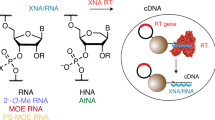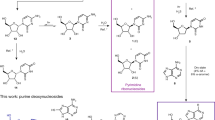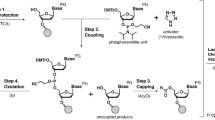Abstract
Hypotheses of the origins of RNA and DNA are generally centred on the prebiotic synthesis of a pristine system (pre-RNA or RNA), which gives rise to its descendent. However, a lack of specificity in the synthesis of genetic polymers would probably result in chimeric sequences; the roles and fate of such sequences are unknown. Here, we show that chimeras, exemplified by mixed threose nucleic acid (TNA)–RNA and RNA–DNA oligonucleotides, preferentially bind to, and act as templates for, homogeneous TNA, RNA and DNA ligands. The chimeric templates can act as a catalyst that mediates the ligation of oligomers to give homogeneous backbone sequences, and the regeneration of the chimeric templates potentiates a scenario for a possible cross-catalytic cycle with amplification. This process provides a proof-of-principle demonstration of a heterogeneity-to-homogeneity scenario and also gives credence to the idea that DNA could appear concurrently with RNA, instead of being its later descendent.
This is a preview of subscription content, access via your institution
Access options
Access Nature and 54 other Nature Portfolio journals
Get Nature+, our best-value online-access subscription
$29.99 / 30 days
cancel any time
Subscribe to this journal
Receive 12 print issues and online access
$259.00 per year
only $21.58 per issue
Buy this article
- Purchase on Springer Link
- Instant access to full article PDF
Prices may be subject to local taxes which are calculated during checkout






Similar content being viewed by others
Data availability
Full experimental details and data are provided in the Supplementary Information. The raw data that support the findings of this study are available from the corresponding author upon reasonable request.
References
Gilbert, W. Origin of life—the RNA world. Nature 319, 618–618 (1986).
Joyce, G. F. & Orgel, L. E. in The RNA World 3rd edn, Vol. 43 (eds Gesteland, R. F., Cech, T. R. & Atkins, J. F.) 23–56 (Cold Spring Harbor Laboratory Press, 2006).
Gesteland, R. F, Cech, T. R. & Atkins, J. F. The RNA World 2nd edn (Cold Spring Harbor Laboratory Press, 1999).
Schwartz, A. in The Molecular Origins of Life: Assembling Pieces of the Puzzle (ed. Brack, A.) 237–254 (Cambridge Univ. Press, 1998).
Orgel, L. E. Prebiotic chemistry and the origin of the RNA world. Crit. Rev. Biochem. Mol. Biol. 39, 99–123 (2004).
Anastasi, C. et al. RNA: prebiotic product, or biotic invention? Chem. Biodivers. 4, 721–739 (2007).
Robertson, M. P. & Joyce, G. F. The origins of the RNA world. Cold Spring Harb. Perspect. Biol. 4, a003608 (2012).
Szostak, J. The eightfold path to non-enzymatic RNA replication. J. Sys. Chem. 3, 2 (2012).
Higgs, P. G. & Lehman, N. The RNA world: molecular cooperation at the origin of life. Nat. Rev. Genet. 16, 7–17 (2015).
Hud, N. V., Cafferty, B. J., Krishnamurthy, R. & Williams, L. D. The origin of RNA and ‘my grandfather’s axe’. Chem. Biol. 20, 466–474 (2013).
Joyce, G. F. The antiquity of RNA-based evolution. Nature 418, 214–221 (2002).
Islam, S. & Powner, M. W. Prebiotic systems chemistry: complexity overcoming clutter. Chem 2, 470–501 (2017).
Krishnamurthy, R. On the emergence of RNA. Isr. J. Chem. 55, 837–850 (2015).
Gavette, J. V., Stoop, M., Hud, N. V. & Krishnamurthy, R. RNA–DNA chimeras in the context of an RNA world transition to an RNA/DNA world. Angew. Chem. Int. Ed. 55, 13204–13209 (2016).
Joyce, G. F., Schwartz, A. W., Miller, S. L. & Orgel, L. E. The case for an ancestral genetic system involving simple analogs of the nucleotides. Proc. Natl Acad. Sci. USA 84, 4398–4402 (1987).
Lazcano, A. & Miller, S. L. The origin and early evolution of life: prebiotic chemistry, the pre-RNA world, and time. Cell 85, 793–798 (1996).
Trevino, S. G., Zhang, N., Elenko, M. P., Luptak, A. & Szostak, J. W. Evolution of functional nucleic acids in the presence of nonheritable backbone heterogeneity. Proc. Natl Acad. Sci. USA 108, 13492–13497 (2011).
Sheng, J. et al. Structural insights into the effects of 2′-5′ linkages on the RNA duplex. Proc. Natl Acad. Sci. USA 111, 3050–3055 (2014).
Engelhart, A. E., Powner, M. W. & Szostak, J. W. Functional RNAs exhibit tolerance for non-heritable 2′–5′ versus 3′–5′ backbone heterogeneity. Nat. Chem. 5, 390–394 (2013).
Eschenmoser, A. The TNA-family of nucleic acid systems: properties and prospects. Orig. Life Evol. Biosph. 34, 277–306 (2004).
Powner, M. W., Zheng, S.-L. & Szostak, J. W. Multicomponent assembly of proposed DNA precursors in water. J. Am. Chem. Soc. 134, 13889–13895 (2012).
Szostak, J. W. An optimal degree of physical and chemical heterogeneity for the origin of life? Phil. Trans. R. Soc. B 366, 2894–2901 (2011).
Orgel, L. E. & Lohrmann, R. Prebiotic chemistry and nucleic acid replication. Acc. Chem. Res. 7, 368–377 (1974).
Woese, C. R. The Genetic Code: The Molecular Basis for Genetic Expression. (Harper and Row, 1967).
Oró, J. & Stephen-Sherwood, E. in Cosmochemical Evolution and the Origins of Life (eds Oró, J., Miller, S. L., Ponnamperuma, C. & Young, R. S.) 159–172 (Springer, Dordrecht, 1974).
Becker, S. et al. Wet–dry cycles enable the parallel origin of canonical and non-canonical nucleosides by continuous synthesis. Nat. Commun. 9, 163 (2018).
Islam, S. et al. Detection of potential TNA and RNA nucleoside precursors in a prebiotic mixture by pure shift diffusion-ordered NMR spectroscopy. Chem. Eur. J. 19, 4586–4595 (2013).
Sutherland, J. D. & Whitfield, J. N. Prebiotic chemistry: a bioorganic perspective. Tetrahedron 53, 11493–11527 (1997).
Usher, D. Early chemical evolution of nucleic acids: a theoretical model. Science 196, 311–313 (1977).
Mehta, A. P. et al. Bacterial genome containing chimeric DNA–RNA sequences. J. Am. Chem. Soc. 140, 11464–11473 (2018).
Song, X.-P., Maiti, M. & Herdewijn, P. Enzymatic synthesis of DNA employing pyrophosphate-linked dinucleotide substrates. J. Sys. Chem. 2, 3 (2011).
Schoning, K.-U. et al. The α-l-threofuranosyl-(3′→2′)-oligonucleotide system (‘TNA’): synthesis and pairing properties. Helv. Chim. Acta 85, 4111–4153 (2002).
Orgel, L. E. Origin of life: a simpler nucleic acid. Science 290, 1306–1307 (2000).
Krishnamurthy, R. Giving rise to life: transition from prebiotic chemistry to protobiology. Acc. Chem. Res. 50, 455–459 (2017).
Pallan, P. S. et al. Why does TNA cross-pair more strongly with RNA than with DNA? An answer from X-ray analysis. Angew. Chem. Int. Ed. 42, 5893–5895 (2003).
Butlerov, A. Formation synthetique d’une substance sucree. Acad. Sci. 53, 145–147 (1861).
Kim, H.-J. et al. Synthesis of carbohydrates in mineral-guided prebiotic cycles. J. Am. Chem. Soc. 133, 9457–9468 (2011).
Kim, H.-J. & Benner, S. A. Prebiotic stereoselective synthesis of purine and noncanonical pyrimidine nucleotide from nucleobases and phosphorylated carbohydrates. Proc. Natl Acad. Sci. USA 114, 11315–11320 (2017).
Weber, A. L. & Pizzarello, S. The peptide-catalyzed stereospecific synthesis of tetroses: a possible model for prebiotic molecular evolution. Proc. Natl Acad. Sci. USA 103, 12713–12717 (2006).
von Kiedrowski, G. A self-replicating hexadeoxynucleotide. Angew. Chem. Int. Ed. 25, 932–935 (1986).
Wu, X., Delgado, G., Krishnamurthy, R. & Eschenmoser, A. 2,6-Diaminopurine in TNA: effect on duplex stabilities and on the efficiency of template-controlled ligations. Org. Lett. 4, 1283–1286 (2002).
Derr, J. et al. Prebiotically plausible mechanisms increase compositional diversity of nucleic acid sequences. Nucleic Acids Res. 40, 4711–4722 (2012).
Yu, H. Y., Zhang, S. & Chaput, J. C. Darwinian evolution of an alternative genetic system provides support for TNA as an RNA progenitor. Nat. Chem. 4, 183–187 (2012).
Xu, J., Green, N., Gibard, C., Krishnamurthy, R. & Sutherland, J. Prebiotic phosphorylation of 2- thiouridine provides either nucleotides or DNA building blocks via photoreduction. Nat. Chem. 11, 457–462 (2019).
Fernando, C., Von Kiedrowski, G. & Szathmáry, E. A stochastic model of nonenzymatic nucleic acid replication: ‘elongators’ sequester replicators. J. Mol. Evol. 64, 572–585 (2007).
Grossmann, T. N., Strohbach, A. & Seitz, O. Achieving turnover in DNA-templated reactions. ChemBioChem 9, 2185–2192 (2008).
He, C., Gállego, I., Laughlin, B., Grover, M. A. & Hud, N. V. A viscous solvent enables information transfer from gene-length nucleic acids in a model prebiotic replication cycle. Nat. Chem. 9, 318–324 (2017).
Duim, H. & Otto, S. Towards open-ended evolution in self-replicating molecular systems. Beil. J. Org. Chem. 13, 1189–1203 (2017).
Ertem, G. & Ferris, J. P. Synthesis of RNA oligomers on heterogeneous templates. Nature 379, 238–240 (1996).
Prakash, T. P., Roberts, C. & Switzer, C. Activity of 2′,5′‐linked RNA in the template‐directed oligomerization of mononucleotides. Angew. Chem. Int. Ed. 36, 1522–1523 (1997).
Mutschler, H. et al. Random-sequence genetic oligomer pools display an innate potential for ligation and recombination. eLife 7, e43022 (2018).
Lutay, A. V., Chernolovskaya, E. L., Zenkova, M. A. & Vlassov, V. V. The nonenzymatic template- directed ligation of oligonucleotides. Biogeosciences 3, 243–249 (2006).
Gibard, C., Bhowmik, S., Karki, M., Kim, E.-K. & Krishnamurthy, R. Phosphorylation, oligomerization and self-assembly in water under potential prebiotic conditions. Nat. Chem. 10, 212–217 (2018).
Vaidya, N. et al. Spontaneous network formation among cooperative RNA replicators. Nature 491, 72–77 (2012).
Taran, O., Thoennessen, O., Achilles, K. & von Kiedrowski, G. Synthesis of information-carrying polymers of mixed sequences from double stranded short deoxynucleotides. J. Sys. Chem. 1, 9 (2010).
Edeleva, E. et al. Continuous nonenzymatic cross-replication of DNA strands with in situ activated DNA oligonucleotides. Chem. Sci. 10, 5807–5814 (2019).
Mutschler, H., Wochner, A. & Holliger, P. Freeze–thaw cycles as drivers of complex ribozyme assembly. Nat. Chem. 7, 502–508 (2015).
Forsythe, J. G. et al. Ester-mediated amide bond formation driven by wet–dry cycles: a possible path to polypeptides on the prebiotic Earth. Angew. Chem. Int. Ed. 127, 10009–10013 (2015).
Joyce, G. F. & Szostak, J. W. Protocells and RNA self-replication. Cold Spring Harb. Perspect. Biol. 10, a034801 (2018).
Ruiz-Mirazo, K., Briones, C. & de la Escosura, A. Prebiotic systems chemistry: new perspectives for the origins of life. Chem. Rev. 114, 285–366 (2014).
Kamat, N. P., Tobe, S., Hill, I. T. & Szostak, J. W. Electrostatic localization of RNA to protocell membranes by cationic hydrophobic peptides. Angew. Chem. Int. Ed. 54, 11735–11739 (2015).
Chen, I. A. & Walde, P. From self-assembled vesicles to protocells. Cold Spring Harb. Perspect. Biol. 2, a002170 (2010).
Joyce, G. F., Inoue, T. & Orgel, L. E. Non-enzymic template-directed synthesis on RNA random copolymers. poly(C, U) templates. J. Mol. Biol. 176, 279–306 (1984).
Prywes, N., Blain, J. C., Del Frate, F. & Szostak, J. W. Nonenzymatic copying of RNA templates containing all four letters is catalyzed by activated oligonucleotides. eLife 5, e17756 (2016).
Pfeffer, D., Sosson, M. & Richert, C. Enzyme-free ligation of dimers and trimers to RNA primers. Nucl. Acids Res. 47, 3836–3845 (2019).
Leu, K., Obermayer, B., Rajamani, S., Gerland, U. & Chen, I. A. The prebiotic evolutionary advantage of transferring genetic information from RNA to DNA. Nucl. Acids Res. 39, 8135–8147 (2011).
Tupper, A., Shi, K. & Higgs, P. The role of templating in the emergence of RNA from the prebiotic chemical mixture. Life 7, 41 (2017).
Dworkin, J. P., Lazcano, A. & Miller, S. L. The roads to and from the RNA world. J. Theor. Biol. 222, 127–134 (2003).
Brewin, N. Catalytic role for RNA in DNA replication. Nat. New Biol. 236, 101 (1972).
Krishnamurthy, R. RNA as an emergent entity: an understanding gained through studying its nonfunctional alternatives. Synlett 25, 1511–1517 (2014).
Ribó, J. M., Hochberg, D., Crusats, J., El-Hachemi, Z. & Moyano, A. Spontaneous mirror symmetry breaking and origin of biological homochirality. J. R. Soc. Interface 14, 20170699 (2017).
Krishnamurthy, R. Life’s biological chemistry: a destiny or destination starting from prebiotic chemistry? Chem. Eur. J. 24, 16708–16715 (2018).
Acknowledgements
The work was supported by a grant from NASA (NNX14AP59G) and the Simons Foundation to R.K. (327124). S.B. thanks the NASA Astrobiology Postdoctoral Program for a fellowship. We thank the S. F. Dowdy laboratory for the use of their instrument for MALDI–TOF analysis. We thank J. Szostak, I. Chen, D. Braun, U. Muller, L. Leman, A. Lazcano and our lab members for helpful discussions.
Author information
Authors and Affiliations
Contributions
R.K. conceived the project. R.K. and S.B. designed the experiments. S.B. performed all the experiments. R.K. wrote the paper with inputs from S.B. Both authors discussed the results and commented on the manuscript.
Corresponding author
Ethics declarations
Competing interests
The authors declare no competing interests.
Additional information
Publisher’s note: Springer Nature remains neutral with regard to jurisdictional claims in published maps and institutional affiliations.
Supplementary information
Supplementary Information
Supplementary information provides details of the synthesis and ligation of TNA–RNA and DNA–RNA chimeric oligonucleotide sequences, and of the stepwise dilution and cross-catalytic self-replication studies.
Rights and permissions
About this article
Cite this article
Bhowmik, S., Krishnamurthy, R. The role of sugar-backbone heterogeneity and chimeras in the simultaneous emergence of RNA and DNA. Nat. Chem. 11, 1009–1018 (2019). https://doi.org/10.1038/s41557-019-0322-x
Received:
Accepted:
Published:
Issue Date:
DOI: https://doi.org/10.1038/s41557-019-0322-x
This article is cited by
-
The First Nucleic Acid Strands May Have Grown on Peptides via Primeval Reverse Translation
Acta Biotheoretica (2023)
-
Prebiotic synthesis and triphosphorylation of 3′-amino-TNA nucleosides
Nature Chemistry (2022)
-
Phosphorylation in liquid sulfur dioxide under prebiotically plausible conditions
Communications Chemistry (2022)
-
Why Should Natural Principles Be Simple?
Philosophia (2022)
-
A robotic prebiotic chemist probes long term reactions of complexifying mixtures
Nature Communications (2021)



